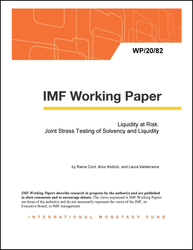
Liquidity at Risk: Joint Stress Testing of Solvency and Liquidity
Liquidity at Risk: Joint Stress Testing of Solvency and Liquidity
READ MORE...
Volume/Issue:
Volume 2020
Issue 082
Publication date: June 2020
ISBN: 9781513546131
$18.00
Add to Cart by clicking price of the language and format you'd like to purchase
Available Languages and Formats
| English |
Prices in red indicate formats that are not yet available but are forthcoming.
Topics covered in this book
This title contains information about the following subjects.
Click on a subject if you would like to see other titles with the same subjects.
Banks and Banking , Finance , WP , balance sheet , variation margin , amount , stress testing , solvency risk , liquidity risk , risk interaction , loss amplification , solvency-liquidity diagram , stress scenario , solvency-liquidity nexus , liquidity-solvency nexus , interactions channels , solvency shock , Financial statements , Liquidity , Solvency , Global
Summary
The traditional approach to the stress testing of financial institutions focuses on capital adequacy and solvency. Liquidity stress tests have been applied in parallel to and independently from solvency stress tests, based on scenarios which may not be consistent with those used in solvency stress tests. We propose a structural framework for the joint stress testing of solvency and liquidity: our approach exploits the mechanisms underlying the solvency-liquidity nexus to derive relations between solvency shocks and liquidity shocks. These relations are then used to model liquidity and solvency risk in a coherent framework, involving external shocks to solvency and endogenous liquidity shocks arising from these solvency shocks. We define the concept of ‘Liquidity at Risk’, which quantifies the liquidity resources required for a financial institution facing a stress scenario. Finally, we show that the interaction of liquidity and solvency may lead to the amplification of equity losses due to funding costs which arise from liquidity needs. The approach described in this study provides in particular a clear methodology for quantifying the impact of economic shocks resulting from the ongoing COVID-19 crisis on the solvency and liquidity of financial institutions and may serve as a useful tool for calibrating policy responses.
Copyright © 2010 - 2024
Powered by:
AIDC



